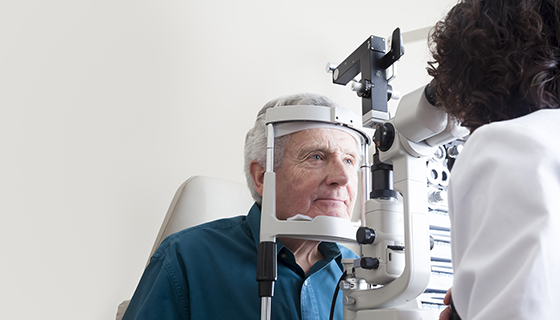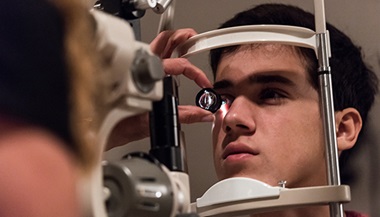Corneal Ring Implants
What is corneal ring implantation?
Corneal ring implantation is surgery to place a ring of plastic into the middle layer of your cornea. This can correct certain problems with your cornea and help you see clearly.
The cornea is a clear layer that covers the front of your eye. It helps protect the rest of your eye from germs and debris. It also helps focus light into your eye. Different conditions can damage the shape of the cornea. If your cornea isn’t the right shape, light rays don’t focus exactly where they should. If this happens, you may have poor vision even when using glasses.
Why might I need corneal ring implantation?
Your eye care provider might advise this surgery if you can't see well due to keratoconus. With keratoconus, your cornea slowly becomes cone-shaped for unknown reasons. Your eye care provider also may use this procedure to treat pellucid marginal degeneration. This is another condition in which the cornea thins abnormally.
Corneal ring implantation is also used to treat nearsightedness (myopia). If you have myopia, you can't see things at a distance without using glasses or contact lenses. With myopia, light rays entering the eye focus in front of your retina instead of on your retina as they should. This can happen because of an abnormally shaped cornea or lens.
If you have corneal ring implantation for myopia, you might not need glasses or contacts anymore. The procedure may work best if you have mild or moderate myopia.
This surgery is an alternative to other procedures that can help correct myopia. These include LASIK (laser in situ keratomileusis) and radial keratotomy. People often have these procedures so that they don't need to wear corrective lenses. Each of these procedures has its own risks and benefits. Ask your eye care provider why corneal ring implantation might make sense for you.
Both LASIK and radial keratotomy can sometimes cause abnormal swelling of your cornea. This can cause new vision problems. If this happens to you, your eye care provider may advise corneal ring implantation. This may stabilize your cornea and correct some of the changes that have happened.
What are the risks of corneal ring implantation?
All procedures have risks. Some possible risks of this procedure include:
-
Keratitis
-
A small hole (perforation) in your eye
-
The ring comes out of the cornea (ring extrusion)
-
Eye swelling
-
Movement of the ring
-
Night halos or glare
-
Long-term (chronic) eye pain
-
Infection
There is also a risk that the surgery might not correct your vision as much as you would like. Or that it might cause another vision problem, such as astigmatism. This is when the curve of the cornea becomes irregular. Some people who have this procedure may need an adjustment surgery to get a better result.
Your risk of complications may be different based on your age, your other health conditions, and the reason for your corneal implant. Ask your eye care provider about your risks for corneal ring implantation.
How do I get ready for corneal ring implantation?
Ask your eye care provider what you need to do to get ready for the surgery. Ask if you need to stop taking any medicines before the procedure. Follow any directions you are given for not eating or drinking before the surgery.
Your eye care provider may want to use special tools to shine a light in your eye and examine your cornea. You may need to have your eyes dilated for this eye exam. You also might need computerized corneal mapping. This will give your eye care provider even more information about your cornea.
What happens during corneal ring implantation?
Talk with your eye care provider about what will happen during your surgery. The details may vary a bit. In most cases, you will have only one eye treated in a single procedure. In general, during the procedure:
-
Most people are awake. You may be given a medicine to help you relax. Your eye care provider may use anesthetic eye drops and shots (injections) to make sure you don’t feel anything.
-
You might get general anesthesia to put you to sleep. This is less common. But if this is the case, you will sleep deeply during the surgery. You won’t remember it afterward.
-
Your surgeon will make small cuts (incisions) in the outer edge of your cornea.
-
Next, they will make tunnels under the outer layer of your cornea.
-
Your surgeon will place the sections of the ring into these tunnels.
-
They will surgically close the cut with very fine stitches.
-
An antibiotic ointment may be applied to your eye to help prevent infection.
-
Your eye will be patched and covered.
What happens after corneal ring implantation?
Ask your eye care provider what to expect after your surgery. In most cases, you will go home the same day. Plan to have someone go home with you after the procedure.
Follow your eye care provider’s instructions about eye care and medicines. You may need to take eye drops with antibiotics to help prevent infection. Your eye may be a little sore after the procedure. But you should be able to take over-the-counter pain medicines. You may need to wear an eye patch for a day or so. Ask your eye care provider if there are any activities you should not do as you recover. Don't rub your eyes.
You will need close follow-up care so your eye care provider can see if the procedure was effective, and watch you for complications. You may have a scheduled appointment the day after the procedure. Tell your eye care provider right away if you have reduced vision or more eye redness, swelling, or pain.
Some people may not need to wear corrective lenses after this surgery. Others may still need to wear lenses. But their vision will be improved overall.
Next steps
Before you agree to the test or the procedure, make sure you know:
-
The name of the test or procedure
-
The reason you are having the test or procedure
-
What results to expect and what they mean
-
The risks and benefits of the test or procedure
-
What the possible side effects or complications are
-
When and where you are to have the test or procedure
-
Who will do the test or procedure and what that person’s qualifications are
-
What would happen if you did not have the test or procedure
-
Any alternative tests or procedures to think about
-
When and how you will get the results
-
Who to call after the test or procedure if you have questions or problems
-
How much you will have to pay for the test or procedure






